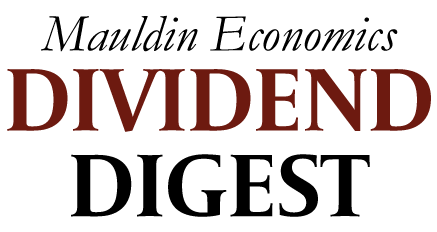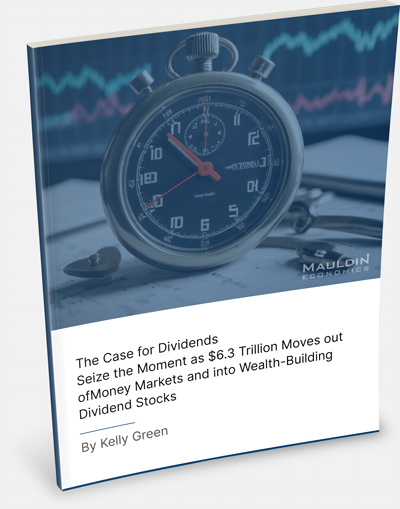
Solving the Income Investor Dilemma
-
 Kelly Green
Kelly Green
- |
- February 19, 2025
- |
- Comments
My friends like to make fun of me by taunting that I don’t like to commit to things. I’m constantly trying new hobbies. I don’t like to make plans too far in advance because something more exciting might pop up. I don’t even like to renew my car tags for more than one year.
I have the opposite problem with my investments. When it comes to those, I’m a bit of a hoarder.
My two-pronged strategy is based on long-term holding. Building wealth through compounding means holding Bedrock Income stocks for years or even decades. It usually takes at least seven years to really see compounding take off. Even my “short term” Current Yield picks are meant to generate income through dividends for “as long as it makes sense.” This could be years as well.
When I find dividend stocks I love, I want to hold them forever and just keep collecting my income. This creates a few issues.
Our money can only be invested in so many places at once. And we want them to be the best investments at the right time. Unless we bring new money to the table, it means selling less optimal positions for new ones. There’s always an opportunity cost.
Income is our main goal, whether we pocket the money or reinvest it. It’s easy to sell a position if it has cut the dividend or a cut looks likely. And it’s easy to cut a position if you’re sitting on a gain and the industry looks like it’s headed for a downturn.
But what about a stock where you’ve locked in a great dividend that keeps rising and the shares keep going up and up? When, if ever, should we shift focus to capital gains instead of our income goals? Is it worth waiting if a potential correction is around the corner?
|
The Steady Income or Big Payday Question
We have two stocks in the Yield Shark portfolio in this position—Philip Morris International (PM) and AT&T (T). I’ve mentioned both of them in past Dividend Digest issues, so you might own them. Let’s take a look.
My readers’ original PM entry date was October 2021 at $94.87. Shares were up another 5% last week hitting $150.46. They’re now up 58.5%.
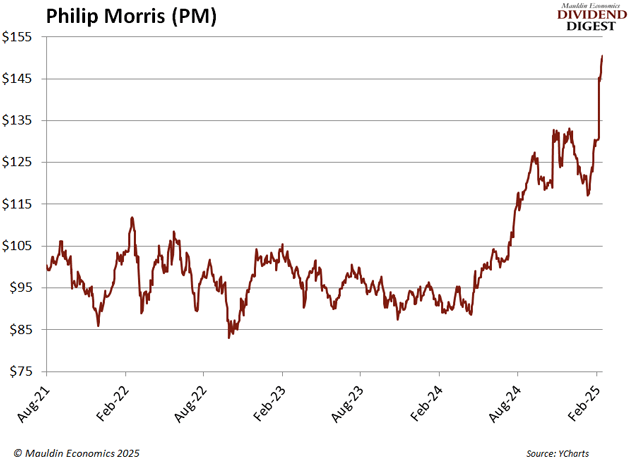
The stock has gone vertical since mid-January. The stock just keeps hitting new all-time highs. The run-up in share price has pushed PM’s current yield down to 3.6%. Yield Shark readers have locked in a yield of 5.7% based on my entry price.
The company dominates the global smoke-free market. Its IQOS, VEEV, and ZYN products continue to gain market share. Management expects smoke-free revenues to grow 12%–14% in 2025. And sales of PM’s combustible products are also growing in markets where smoke-free products are banned.
Our original entry date for AT&T was May 2023 at $15.95. The stock also gained 5% last week reaching $25.87. Yield Shark readers are sitting on a 62% gain.
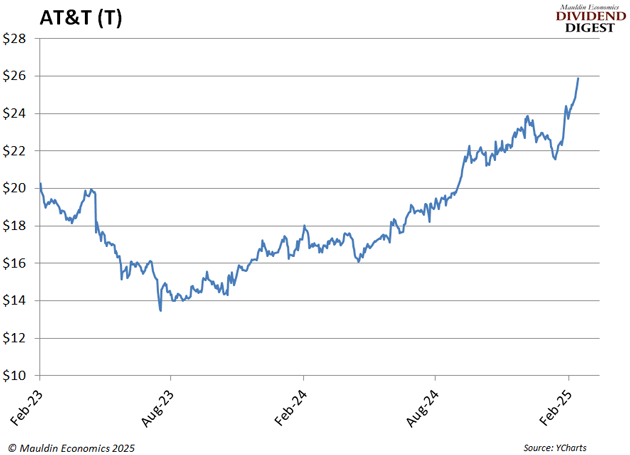
The stock has reached multiyear highs. This has dropped AT&T’s current yield to 4.3%, but I locked in 7% based on my entry price.
The company has had six straight quarters of positive broadband net adds, consistent wireless adds, and the lowest postpaid phone churn across the industry. Plus, in December, the company unveiled its strategy to drive both sustainable company growth and enhanced shareholder returns over the next two years.
The outlook for future growth and dividend payouts is bright for both companies. But gains of 58% and 62% can tempt you to sell before something happens that sways investor sentiment.
Lock In Tomorrow’s Income, Today
Like what you're reading?
Get this free newsletter in your inbox every Wednesday! Read our privacy policy here.
If that’s the lens used to view our investments when we buy, shouldn’t we use the same lens when we think about selling? If so, let’s look at those two stocks a little differently.
The PM share price gain is 58%, and the effective yield is 5.7%. That means if you sell today, it would be the equivalent of pocketing 10 years of income. I think we can all agree that time is money.
For T, the share price gain is 62%, and the effective yield is 7%. Selling today would mean fast-tracking almost nine years of income.
Keep in mind that PM is a Bedrock Income position and T is a Current Yield position.
Bedrock Income positions are stocks you want to use for dividend reinvestment and hold for potentially decades to come. So, we need to ask: Do I still think the company will grow for decades? Yes, my long-term expectations remain incredibly bullish for PM.
Current Yield positions are different. They only belong in your portfolio for as long as it makes sense. For T, we are still collecting a 7% effective yield… and shares are still going up.
Finally, don’t forget to think about your risk tolerance and emotional health. If thinking about big unrealized gains keeps you up at night, worrying that they could drop at any moment–sell the stock. If you go this route, don’t beat yourself up if the stock heads higher. Sell and move on.
My official recommendation for both stocks right now is to continue to hold. I think PM is still a great long-term holding that will continue to raise its dividend. For AT&T, if shares start to make a U-turn, I’ll recommend taking those gains and deploy the cash into the next great Current Yield opportunity.
|
For more income, now and in the future,
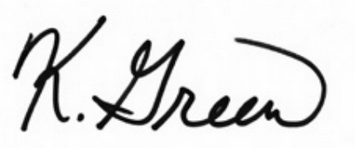
Kelly Green

 Kelly Green
Kelly Green